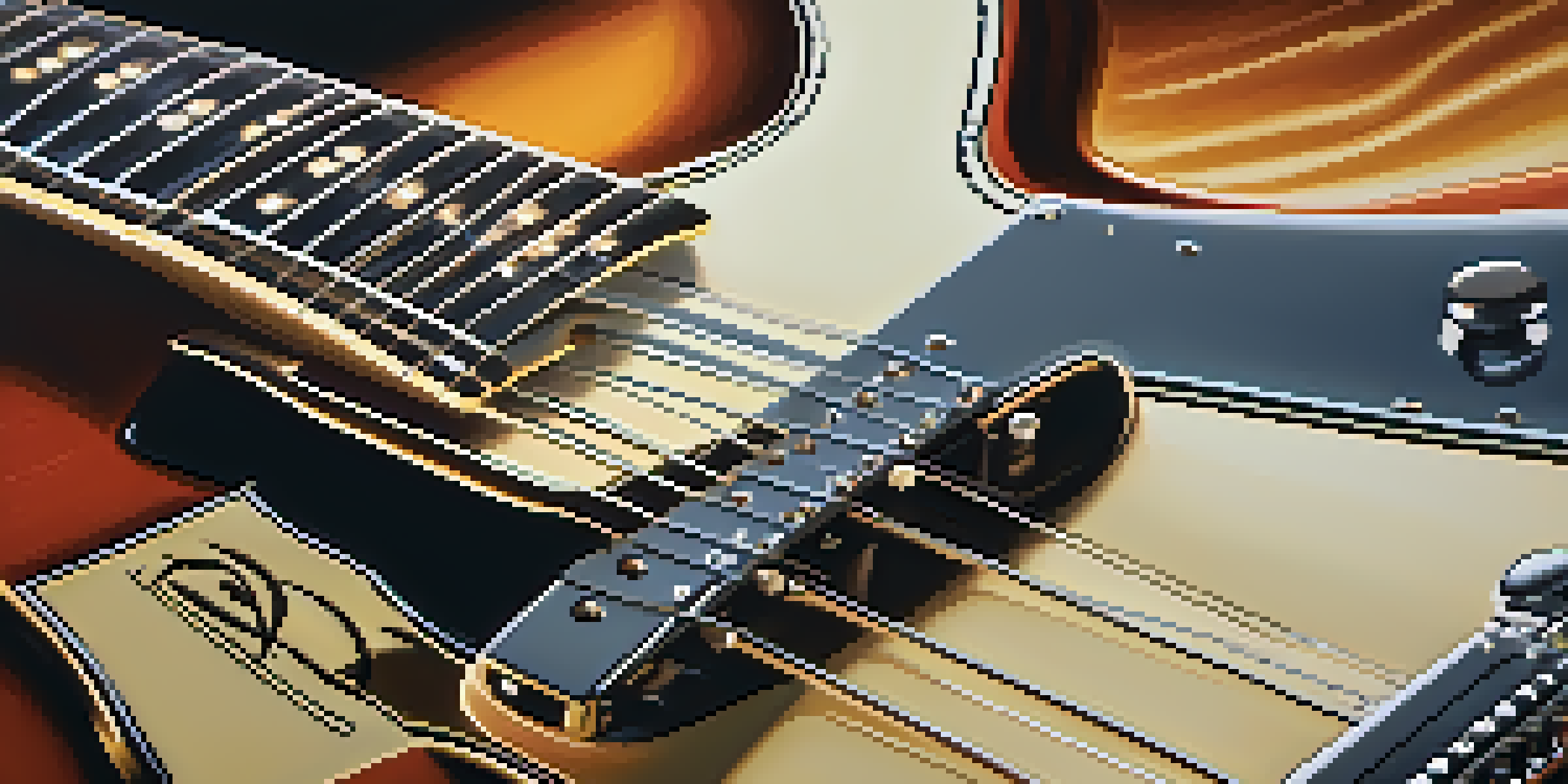The Impact of Jimi Hendrix on Modern Guitar Techniques Today

Jimi Hendrix: A Revolutionary Force in Guitar History
Jimi Hendrix is often regarded as a revolutionary figure in music, particularly in guitar playing. His innovative approach to the instrument not only changed how guitarists perform but also how music is created. By blending blues, rock, and psychedelia, he introduced a sound that was both unique and influential, setting the stage for future generations of musicians.
Jimi Hendrix is a brilliant guitarist and a great composer. He really opened up the door to a whole new realm of guitar playing.
Hendrix's ability to push the boundaries of traditional guitar playing is evident in his iconic performances, like at Woodstock in 1969. His use of feedback, distortion, and the whammy bar gave his music a raw, expressive quality that had never been heard before. This fearless exploration opened doors for guitarists to experiment with tone and techniques, creating a ripple effect throughout the music industry.
Today, Hendrix's impact can be seen in countless genres, from rock to metal to blues. Many modern guitarists cite him as a primary influence, and his techniques are studied in music schools worldwide. His legacy not only lives on through his recordings but also through the countless musicians inspired by his groundbreaking style.
Signature Techniques: The Birth of New Styles
One of Hendrix's signature techniques was his use of string bending, which added emotional depth to his solos. By bending notes, he could mimic the human voice, creating a sound that resonated with listeners on a personal level. This technique has since become a staple in guitar playing, influencing countless artists who strive to evoke similar emotions in their music.

Additionally, Hendrix's mastery of the thumb-over technique allowed him to play bass notes and chords simultaneously, creating a fuller sound. This approach not only showcased his technical prowess but also inspired guitarists to explore new ways of chord voicing. Today, many players incorporate this technique into their own playing, demonstrating its lasting relevance.
Hendrix Redefined Guitar Techniques
Jimi Hendrix's innovative techniques, such as string bending and the thumb-over method, revolutionized guitar playing and inspired countless musicians.
Moreover, his use of unconventional scales and modes challenged traditional music theory. By experimenting with the minor pentatonic and blues scales, he transformed how solos were approached, encouraging guitarists to think outside the box. As a result, modern guitarists often blend various scales to create distinct sounds, all thanks to Hendrix's pioneering spirit.
Innovative Use of Effects Pedals
Hendrix was not just a master of the guitar; he was also a pioneer in using effects pedals to shape his sound. He famously employed the fuzz pedal to create a gritty, distorted tone that became his signature. This innovative use of technology not only influenced his own music but also set a precedent for how effects could be utilized in rock music.
Hendrix was the only guitarist who could make a guitar scream and cry at the same time.
His experimentation with the wah-wah pedal further showcased his adventurous spirit. By manipulating the pedal during solos, he created dynamic, vocal-like sounds that captivated audiences. This technique has since become a hallmark of rock guitar playing, with many contemporary guitarists employing it to add expressiveness to their performances.
Today, the landscape of effects pedals has exploded, with guitarists having access to an array of sounds and textures. However, it is Hendrix's early explorations that paved the way for this revolution. Modern musicians continue to push the boundaries of what is possible, always looking to capture that Hendrix magic in their own unique ways.
The Role of Improvisation in Hendrix's Style
Improvisation was a cornerstone of Hendrix's playing style, allowing him to create spontaneous, memorable performances. His ability to weave in and out of songs, incorporating unexpected solos and riffs, added an exciting element to live shows. This emphasis on improvisation encouraged many guitarists to embrace spontaneity in their own performances, making each show a unique experience.
Moreover, Hendrix's improvisational skills were deeply rooted in his understanding of music theory and feel. He often blended genres, seamlessly transitioning between blues licks and rock riffs, which inspired guitarists to explore beyond their primary genre. This fluidity has become a hallmark of modern guitar playing, as musicians strive to find their own voice through improvisation.
Cultural Icon of the 1960s
As a symbol of the counterculture movement, Hendrix's music and flamboyant style encouraged artists to express their individuality and challenge societal norms.
As a result, many contemporary guitarists prioritize improvisation in their practice and performances. They seek to capture the essence of spontaneity that Hendrix embodied, often using jam sessions as a way to experiment and grow musically. This enduring influence highlights how Hendrix's improvisational approach continues to inspire creativity in guitarists around the world.
Cultural Impact: Hendrix and the Counterculture Movement
Jimi Hendrix emerged as a cultural icon during the 1960s counterculture movement, symbolizing freedom and artistic expression. His music resonated with a generation seeking change, and his performances became legendary for their electrifying energy and message. This connection between music and culture has inspired modern guitarists to embrace their own identities and use their art as a platform for social commentary.
Hendrix's style, both musically and visually, broke down barriers and challenged societal norms. His flamboyant fashion choices and on-stage persona encouraged artists to express themselves authentically, leading to a more diverse music scene. This spirit of individuality remains a driving force in today’s music, as artists continue to forge their unique paths.
Furthermore, the celebration of Hendrix's legacy in popular culture reflects his enduring influence. Documentaries, tribute concerts, and countless covers of his songs serve as reminders of his impact. Modern guitarists often draw inspiration from this cultural significance, using their music not just as entertainment but as a means to connect with larger movements.
The Legacy of Hendrix in Modern Guitar Education
Jimi Hendrix's influence extends beyond performance; it is deeply embedded in modern guitar education. Many music schools incorporate his techniques and style into their curricula, ensuring that new generations of musicians understand his contributions. From learning iconic riffs to studying his improvisational approach, Hendrix's legacy is a crucial part of guitar education today.
Guitar instructors often use Hendrix's songs as teaching tools, illustrating key concepts such as string bending, use of effects, and improvisation. By analyzing his work, students gain insights into not only technical skills but also the emotional depth that music can convey. This hands-on learning approach keeps Hendrix's spirit alive in the classroom.
Legacy in Modern Education
Hendrix's contributions to guitar playing are integral to contemporary music education, with his techniques and improvisational skills taught in schools worldwide.
Additionally, online resources and tutorial videos dedicated to Hendrix's techniques have made his influence more accessible than ever. Aspiring guitarists can easily find lessons focused on his style, ensuring that his innovative spirit continues to inspire. As a result, Hendrix's legacy remains a vital aspect of guitar education, shaping the musicians of tomorrow.
Hendrix's Influence on Diverse Genres
While Jimi Hendrix is often associated with rock and blues, his influence stretches across various genres, including jazz, funk, and even hip-hop. Guitarists in these styles have adopted his techniques, integrating them into their own musical expressions. This cross-genre appeal illustrates the universality of Hendrix's style and the adaptability of his techniques.
For instance, funk guitarists often cite Hendrix's rhythm playing as a foundational influence. His use of syncopation and percussive strumming has become a defining characteristic of funk music. This blending of genres showcases how Hendrix's approach can transcend traditional boundaries, inspiring musicians to experiment and innovate.

Moreover, contemporary hip-hop artists frequently sample Hendrix's work, bringing his sound to new audiences. This fusion of rock and hip-hop highlights how his influence continues to evolve, ensuring that his legacy remains relevant in today's music landscape. As genres continue to merge, Hendrix's techniques serve as a common thread connecting diverse musical expressions.